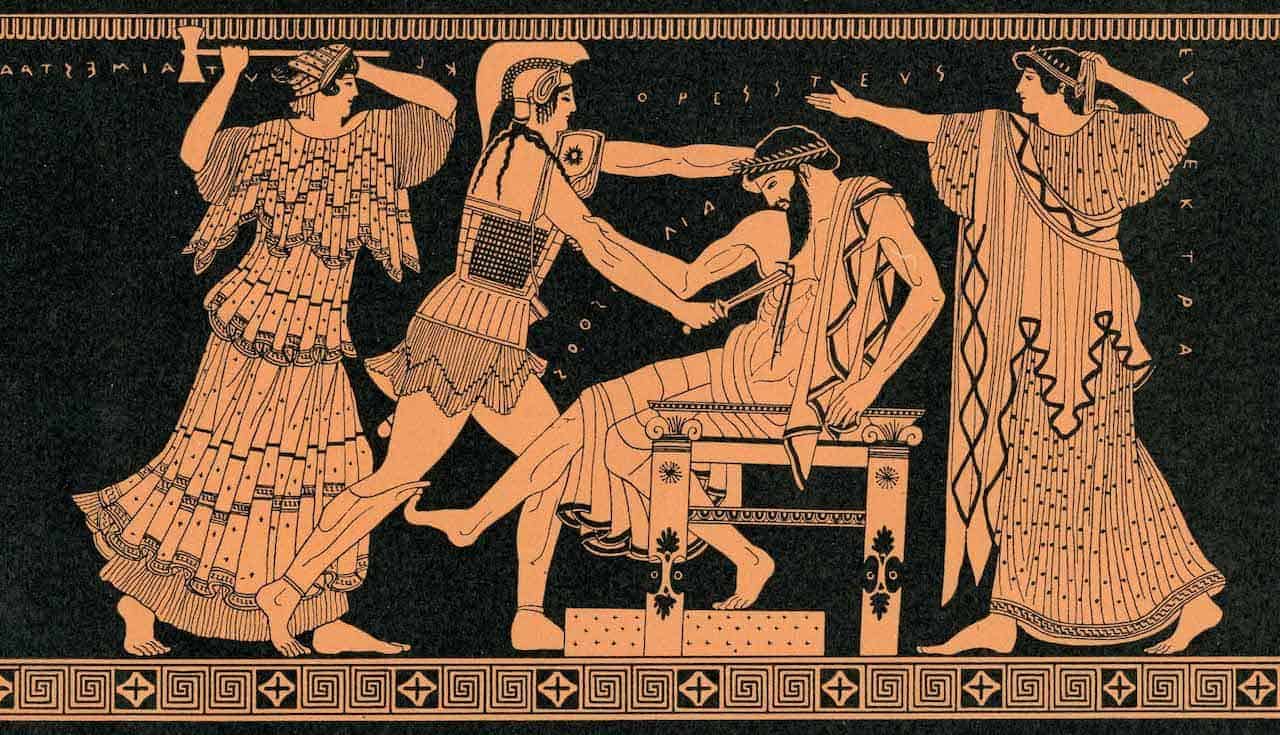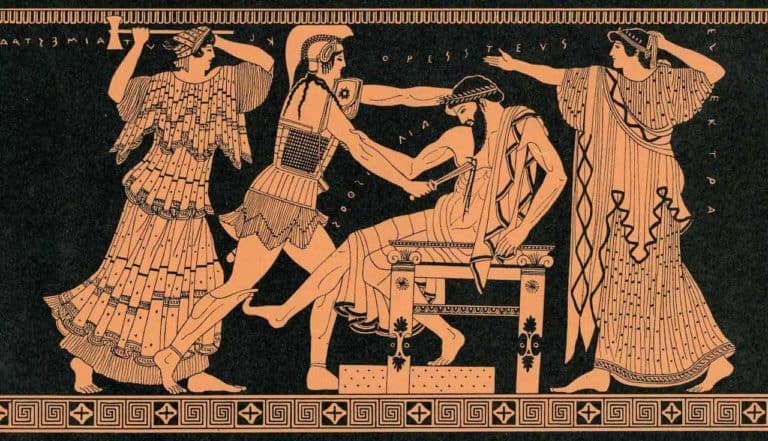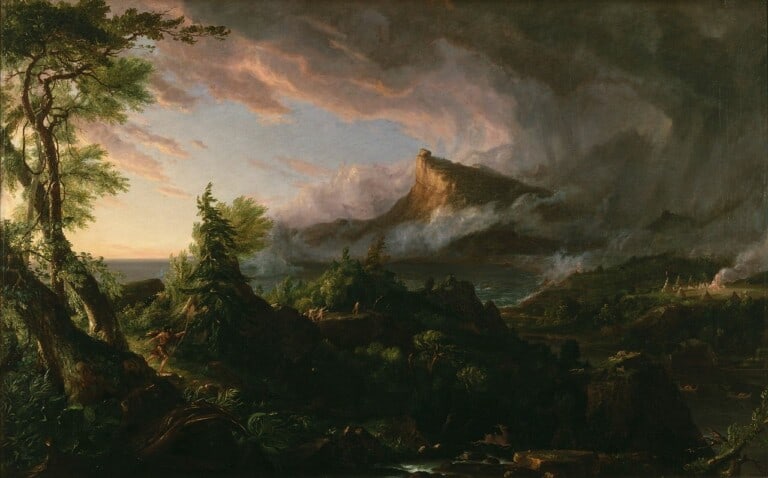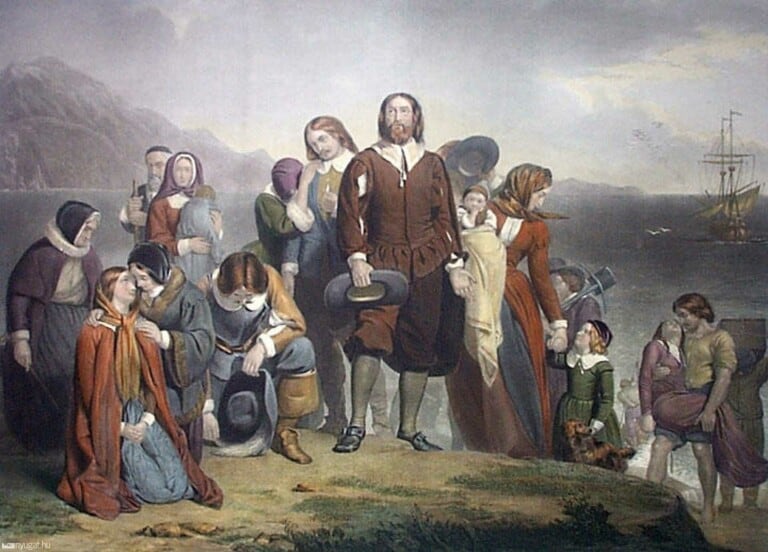Mythe de la vérité, la tragédie d’Électre est le récit d’une vengeance qui s’accomplit à ce titre. Le conflit qui structure la pièce lui donne unité et profondeur.

Mais quelles sont les origines et les règles de la tragédie grecque?
Quel mythe est à l’origine du drame d’Électre ?
Quelle est l’originalité de Giraudoux par rapport aux célèbres dramaturges que furent Eschyle, Sophocle ou Euripide?
I. Naissance de la tragédie
A. Origines religieuses du théâtre
La tragédie est née à Athènes au Vème siècle avant Jésus-Christ. Issues du culte de Dionysos, les représentations dramatiques ne cessent de revêtir un caractère sacré comme en témoignent les faits suivants:
L’autel, autour duquel le choeur évolue, est placé au centre de l’orchestra de forme circulaire.
Le célèbre théâtre grec d’Epidaure s’élevait dans l’enceinte sacrée d’Asclépios, où “aucun enfant ne devait naître et où l’on ne laissait mourir que des acteurs tragiques sur la scène”.
Sur les fauteuils du premier rang des gradins de ce même théâtre, on lit encore les inscriptions suivantes: Prêtre de Zeus Olympios – Prêtre d’Apollon Délios – Prêtre des douze dieux – Prêtre d’Asclépios…
Les représentations, qui ont lieu deux fois par an, coïncident avec les Fêtes lénéennes, en février, et les grandes Dionysies, à la fin mars.
A la fin de la représentation, le poète paraît, la tête couronnée, comme il était d’usage dans toute cérémonie religieuse.
Le costume des acteurs n’est autre que celui des prêtres de Dionysos.
Le masque dont ils se couvraient toujours le visage demeurait une survivance des anciens rites.
Le choeur, dont la participation au drame est incessante, avertit le spectateur que l’action se déroule sur un autre plan que le plan humain.
B. Des fêtes de Dionysos à la tragédie
C”est du nom “bouc”- en grec “tragos”- sacrifié aux dieux lors des grandes Dionysies, que provient le mot “tragédie”.
Entre les hymnes, que des choeurs chantaient en l’honneur de Dionysos, vient s’intercaler un récit, ou grave ou gai, emprunté à la vie d’un dieu, d’un demi-dieu ou d’un héros, mimé puis joué. Le drame est né.
C. Le théâtre grec
Les représentations ont toujours lieu en plein air.
Dans la structure du théâtre d’Epidaure, on distingue quatre parties:
- l’hémicycle, avec ses gradins creusés au flanc de la colline
- l’orchestra, circulaire, enclavé aux trois-quarts par les gradins
- le proscenion, terrasse peu élevée située derrière l’orchestra
- la scène, bâtiment où les acteurs se costument, situé derrière le proscenion, et dont les murs soutiennent les décors (Les décors d’abord massifs, en plein bois, ne sont peints que bien plus tard).
Les interprètes de la tragédie grecque -tous des hommes- se composaient de 15 choreutes et de 3 acteurs, jamais plus de trois, qui, grâce au masque, pouvaient chacun jouer plusieurs rôles.
Les uns et les autres, tirés au sort, pouvaient aussi bien être choisis parmi les métèques que les esclaves. Le chorège, citoyen riche, tiré lui aussi au sort, avait charge de nourrir et d’entretenir acteurs et choreutes.
Les acteurs étaient vêtus de costumes somptueux, ceux des prêtres de Dionysos: tunique aux longues manches, descendant jusqu’aux pieds. Ils remontaient leur ceinture pour se grandir et chaussaient de hauts cothurnes.
Les masques étaient faits d’un assemblage de chiffons stuqués, pressés dans un moule et recouverts d’un crépi de plâtre.
ous son manteau richissime, vert ou pourpre, rehaussé de broderies d’or, l’acteur ainsi vêtu, ainsi chaussé, ainsi masqué, produisait un effet bizarre et surhumain.
D. Structure de la tragédie grecque
La tragédie grecque a une structure immuable: elle se compose d’un prologue, de trois épisodes et d’un exode.
Il n’y a aucun entracte entre ces cinq actes. Seul intervient le choeur qui, par la voix de son chef, le coryphée, ou de toutes ses voix, dialogue avec l’acteur.
Aussitôt après le prologue, par cinq rangs de trois choreutes chacun, le choeur fait son entrée sur un pas gravement dansé. Cette danse consistait en une suite de mouvements appelés “marches” et de poses appelées “figures”.
La figure rendait l’expression de la personne; la marche l’action et la passion. Par exemple après le meurtre d’Égisthe dans l’Électre d’Euripide, le choeur se mettait à danser une danse plus vive.
La tragédie classique est régie par la règle des trois unités:
- unité de temps
- unité de lieu
- unité d’action
L’action de la tragédie classique se déroule, en effet, en un jour, de l’aurore au coucher du soleil. C’est dans le temps qui sépare les différents actes que l’action évolue, chaque acte permettant de prendre en compte l’évolution qui vient d’avoir lieu.
Dans la mythologie grecque, le destin se déchaîne souvent contre un petit nombre de victimes désignées, coupables d’arrogance, de démesure: c’est le cas des Atrides qui expient le crime de leur aïeul.
II- Le mythe d’Électre dans la tragédie grecque
A. Une malédiction divine implacable
Le mythe d’Électre apparaît dans la littérature grecque dès le VIIIe siècle avant Jésus-Christ et se développe surtout dans trois grandes tragédies du Ve siècle avant Jésus-Christ.
L’histoire d’Électre, c’est d’abord une affaire de famille, celle des Atrides, qui doit son nom à Atrée, père d’Agamemnon, tragiquement célèbre parce que sa haine pour son frère Thyeste a fait basculer tous les membres de cette famille et leur descendance dans un univers particulièrement sombre, où se conjuguent cruauté, monstruosité et démesure.
C’est l’acte de Tantale, grand-père d’Atrée, qui est à l’origine de cette malédiction. Tantale, bien qu’admis à la table des dieux, s’était rendu coupable de plusieurs fautes graves à leur égard.
Il les avait offensés par son orgueil démesuré, leur aurait donné à manger son propre fils Pélops, qu’il avait immolé, et leur aurait dérobé leur boisson et leur nourriture, le nectar et l’ambroisie. Pour tout cela, il fut condamné à un supplice éternel dans les Enfers: dès qu’il voulait boire ou manger, eau et nourriture se dérobaient.
Pélops, ressuscité par les dieux, obtint par ruse la main d’Hippodamie, fille d’Oenomaos, réputé imbattable dans les courses de chars. Malheureusement, infidèle à sa promesse de donner la moitié de son royaume au cocher Myrtilos qu’il avait soudoyé, il fait jeter celui-ci à la mer, qui avant de mourir le maudit à son tour, lui et sa descendance.
Obéissant à cette fatalité, les deux fils de Pélops se haïssent et s’affrontent. Si Thyeste séduit la femme d’Atrée, Atrée tue les enfants de son frère, les lui fait manger et lui révèle l’horreur de ce festin ! A son tour, Thyeste lance la malédiction sur Atrée et toute sa descendance.
Un autre enfant, né de l’union incestueuse de Thyeste avec sa propre fille, va accomplir le destin de sa race. Il se nomme Égisthe et, non content d’avoir séduit la femme d’Agamemnon, il tue ce prestigieux cousin, roi de Mycènes et “roi des rois”.
Sept ans après la mort de son père, Oreste, fils d’Agamemnon, écarté d’Argos par sa mère y revient pour retrouver sa soeur Électre, qui le pousse à accomplir son inexorable destin. Aidé par Électre, Oreste venge la mort de son père en tuant Égisthe et Clytemnestre, et reprend le trône d’Argos.
La fortune dramatique du mythe d’Électre repose sur les possibilités qu’offre une telle histoire par la dramatisation de ses éléments constitutifs :
- personnages hors du commun,
- destin tragique,
- interrogations sur la liberté et la responsabilité.
Un tel mythe favorise, par la richesse des thèmes qui s’entrecroisent, une large interprétation.
B. Électre et les dramaturges de l’Antiquité
Dès l’Antiquité grecque de nombreux poètes et dramaturges se sont intéressés au personnage d’Électre.
En 458 avant J.-C., Eschyle compose et fait jouer sa trilogie de l’Orestie (trois pièces traitant le même thème).
La première tragédie évoque le meurtre du roi (Agamemnon), la seconde la vengeance (Les Choéphores) et la troisième le châtiment du fils (Les Euménides). Le sens du sacré parcourt l’ensemble de l’oeuvre. C’est un ordre d’Apollon qui conduit le bras meurtrier d’Oreste.
Vers 415 avant J.-C., Sophocle reprend le sujet dans Électre, mais il le conçoit très différemment. C’est lui qui fait de la jeune fille l’âme de la vengeance. Être de passion et de démesure, elle clame sa haine en accompagnant les cris de l’agonie maternelle de sa propre joie.
A la même époque, Euripide propose une autre version d’Électre, donnant à la pièce des allures de “tragédie bourgeoise”. Si l’héroïne se déchaîne toujours contre sa mère, c’est pour des raisons humaines et mesquines.
Venge-t-elle un père ou assouvit-elle une haine de femme ? Incohérente, elle succombe brutalement au remords et aux larmes, sitôt le crime commis, comme purgée de sa haine.
C. Électre et la scène moderne
Le mythe d’Électre est ensuite abandonné et il faut attendre les XVIIème et XVIIIème siècles pour voir les dramaturges reprendre le mythe.
Crébillon fait représenter en 1708 une Électre qui ne manque ni de puissance, ni de violence.
Voltaire, qui donne un Oreste en 1750, ainsi qu’Alfieri avec ses deux pièces Agamemnon et Oreste (1783), créent un contexte et des personnages moins violents, plus loin de l’univers d’Eschyle.
Proposant une approche plus nouvelle de la tragédie d’Eschyle, Eugen O’Neil compose Le deuil sied à Électre en 1931.
Enfin Sartre, en 1943, propose sa propre démarche avec la représentation de sa première pièce, Les Mouches , où Oreste et Électre, dans un “théâtre de situations” y deviennent les conquérants pleinement responsables de leur liberté.
III. l’interprétation de Giraudoux
Dans l’interprétation d’Électre, en 1937, mise en scène par Louis Jouvet au théâtre, Giraudoux respecte la tradition antique, l’époussette et la modernise.
Le drame giralducien se déroule suivant la règle des trois unités conformément à la tradition grecque:
Unité de lieu: Giraudoux choisit de faire faire à Oreste une visite guidée mythologique du palais. (Lire:”La fenêtre au jasmin”.)
Unité de temps et d’action: l’acte I se déroule depuis la fin de l’après-midi jusqu’au milieu de la nuit, l’entracte occupe une partie de la nuit, et l’acte II commence peu avant le jour pour finir à l’aurore.
Giraudoux concentre volontairement sa pièce sur une durée très brève: l’action dure au total une douzaine d’heures. Mais on voit qu’ici Giraudoux a respecté la règle tout en le renversant de manière parodique: l’action commence en fin de journée pour s’achever le lendemain au lever du soleil!
De même que tout en respectant la règle de l’unité de temps, Giraudoux réserve le temps qui sépare les deux actes au sommeil des héros, c’est-à-dire à l’inaction!
Les éléments tragiques d’Électre se retrouvent aussi bien chez les dramaturges de l’Antiquité que chez les auteurs modernes:
La fatalité, le “fatum”, cette force supérieure qui détermine tout par avance est bien présente. Ainsi, Électre doit “se déclarer”, mais également Égisthe, Agathe et Clytemnestre. Chaque personnage agit en fonction d’un rôle déterminé par avance. Chaque événement est inéluctable, des révélations au meurtre final.
Le divin est représenté de trois façons différentes :
- par les Euménides, déesses de la vengeance,
- par le mendiant, dont l’identité est ambiguë: homme ou dieu ?
- par l’oiseau qui plane au-dessus de la tête d’Égisthe.
L’état de crise sur lequel s’ouvre la pièce -réactions au mariage d’Électre- détermine les conflits entre familles et au sein des familles. Aux conflits familiaux s’ajoute la crise politique: menace d’invasion d’Argos par les Corinthiens.
De plus, pas de tragédie sans transgression : en évoquant l’abominable festin d’Atrée dans son exposition, en suggérant l’inceste latent, l’amour interdit d’Électre pour Oreste, en créant une Électre implacable de démesure et d’orgueil, Giraudoux respecte les fondements du tragique et demeure fidèle à ses modèles grecs.
Toutefois Giraudoux se démarque de ses prédécesseurs.
Dans son Électre en deux actes et en prose, Giraudoux supprime les choeurs. Le rôle de celui-ci est assuré par le Mendiant et les Euménides. Les Euménides, divinités de la vengeance, petites filles au début de la pièce, sont de la taille d’Électre à la fin. Elles représentent le destin en marche.
Le Mendiant, témoin, détective, accoucheur de vérité, joue le rôle de porte-parole du destin qu’il met en lumière. Il commente les paroles et les actions des personnages. Il est l’interlocuteur des protagonistes Égisthe et Électre qu’il guide et éclaire dans la voie qui les mène à la réalisation de leurs destins réciproques.
Dans l’entracte, le Lamento du Jardinier rompt l’illusion scénique pour rappeler aux spectateurs ce que la pièce ne montre pas, la devise de la vie qui, pour lui, est “Joie et Amour”.
Giraudoux conserve les personnages et la trame du mythe antique mais les vide de leur signification première en substituant à l’émotion sacrée la fantaisie railleuse, l’incongruité des anachronismes et le jeu parodique qui réduit la majesté divine à la trivialité humaine.
Les dieux, cruellement absents ne sont évoqués que par leur indifférence.
Enfin, Giraudoux diffère du ton tragique par le style de son écriture, qui se manifeste par la préciosité et le burlesque.
La préciosité
Le style dramatique de son écriture est qualifié de précieux par sa recherche du mot précis, par l’importance de la métaphore et de l’antithèse comme moyens stylistique pour suggérer une image digne et poétique de la vie en opposition aussi avec un aspect plus prosaïque de l’humanité.
Par exemple, Giraudoux aime déployer toutes les nuances de la langue, jongler avec les mots, jouer avec les synonymes, utiliser les divers registres de langue: par exemple le terme “se déclarer” expliqué par le mendiant pour éclairer le double sens du verbe: “dire” et “devenir ce que l’on est” :
"Quel jour devient-elle Électre ?" (I, 3).
En particulier, il aime les énumérations de termes concrets et abstraits mis sur le même plan, comme dans I,3 :
"Pourquoi les orages survolent-ils nos vignes, les hérésies, nos temples…" (I, 3)
Dans Électre, les animaux sont utilisé comme des symboles. En parlant de sa haine, Électre dit :
"Elle te lèche comme le chien la main qui va le décupler. Je sens que tu m'as donné l'odorat de la haine".
D’ailleurs la métaphore se poursuit en filant l’image du chien de chasse: “J’ai pris la piste”.
Le burlesque
Le burlesque consiste à parler des réalités élevées en style familier, il est omniprésent dans le théâtre giralducien.
Le comique résulte du jeu des disproportions, souligné par le jeu des anachronismes comme pour le mendiant qui parle de la “faute originelle” ou des “honoraires et (de) son pourcentage” dans la bouche d’Égisthe.
On trouve aussi des associations bouffonnes de l’abstrait et du concret du style :
"elle va (…) monter le prix du beurre et faire arriver la guerre".
La fréquence des coq-à-l’âne, des conversations décousues ou des alignements de séries d’antithèses fait penser à un jeu gratuit tels les “couplets” du mendiant sur les hérissons à l’acte I, scène 2.
Conclusion
En se démarquant des représentations tragiques d’Électre de ses prédécesseurs, Giraudoux recommande plutôt un art de vivre, qui consiste à faire front, s’il le faut, avec courtoisie aux forces qui nous détruisent et d’apposer à ces forces le sourire de l’acceptation et le sentiment très vif de la fraternité humaine.
Giraudoux préconise une sagesse à la mesure humaine en s’efforçant d’exorciser le tragique et de délivrer l’homme de la fatalité géographique, historique et culturelle.
En se réappropriant le mythe d’Électre, Giraudoux a su séduire le public moderne grâce au pouvoir magique de mots capables de représenter et d’ordonner l’univers à la dimension humaine.
Le jardinier explique dans son Lamento, en dehors de l’action de la pièce, le vrai sens de celle-ci :
"Joie et amour, oui. Je viens vous dire que c"est préférable à aigreur et haine."








